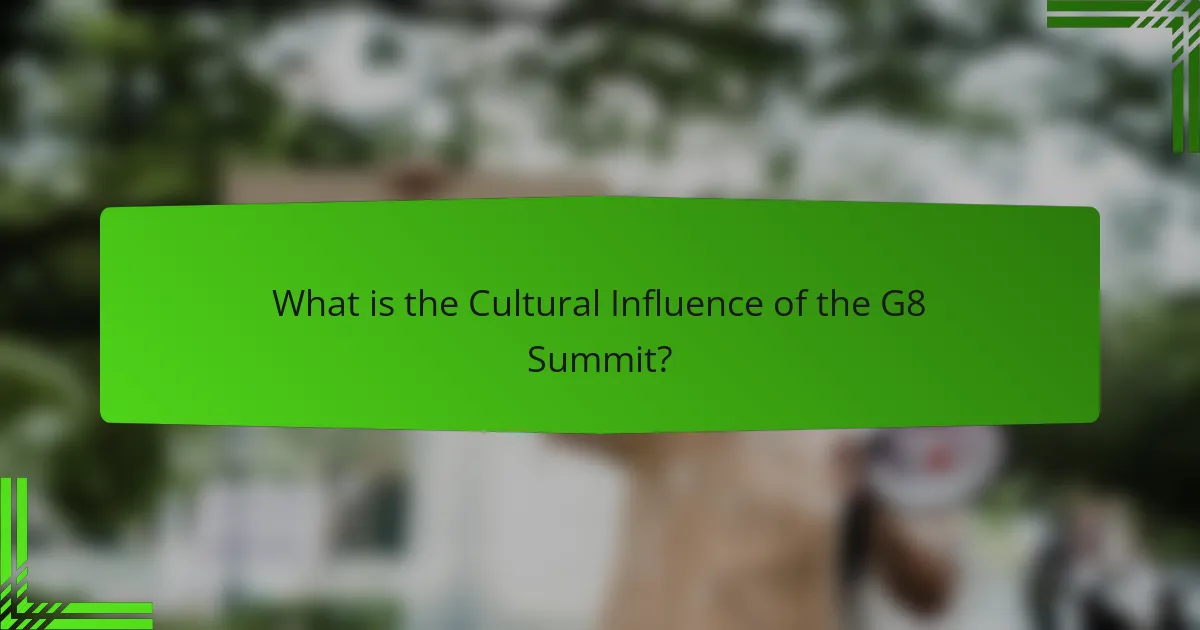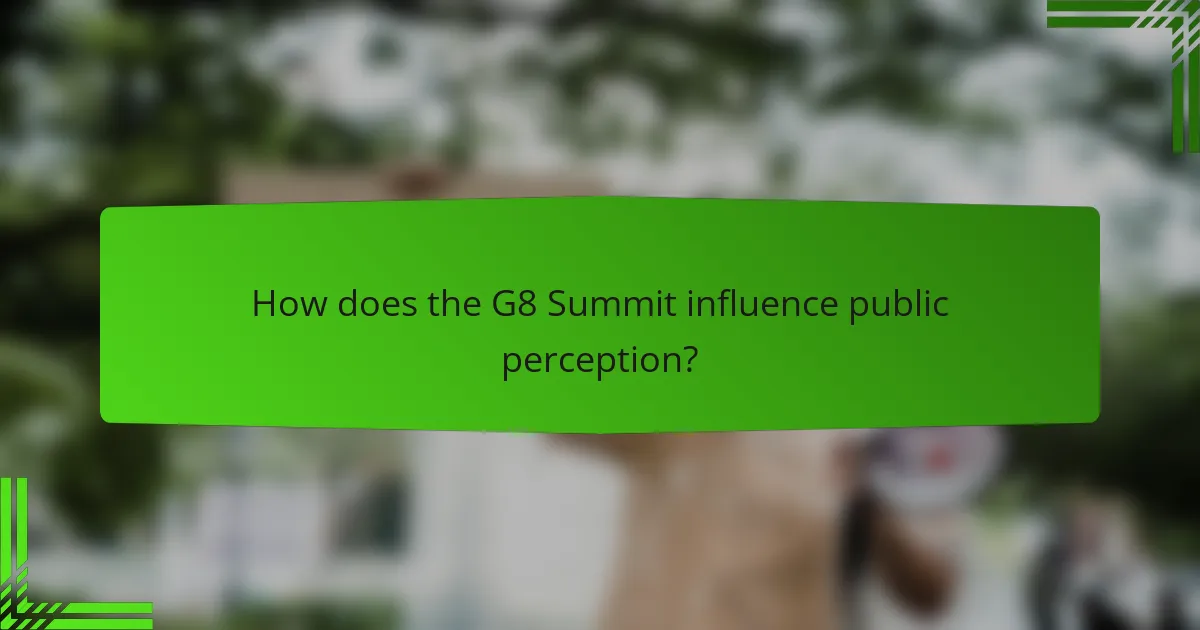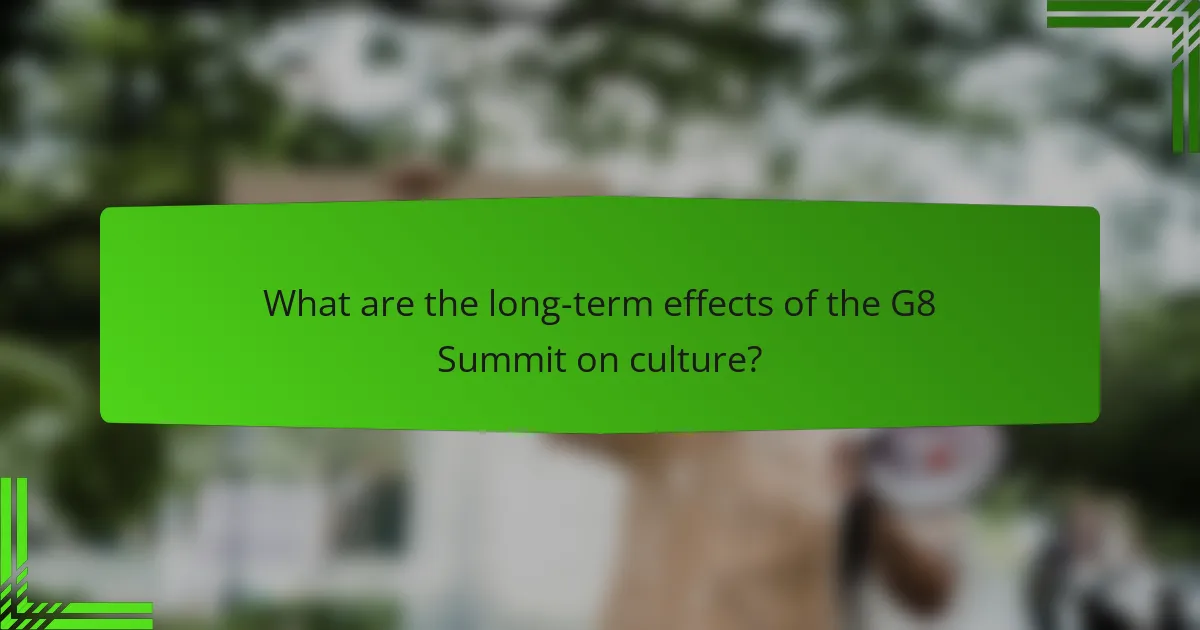The G8 Summit is a significant international event that influences culture by shaping global discourse on critical issues such as climate change, economic development, and security. It convenes leaders from major economies, leading to cultural shifts in public perception and media representation. The outcomes of the summit often inspire art, activism, and media coverage that enhance public awareness and engagement with global challenges. Furthermore, the G8 Summit promotes international collaboration in cultural initiatives, fostering cross-cultural understanding and supporting diverse perspectives. Overall, the summit plays a crucial role in facilitating dialogue and cultural exchange among nations, with lasting impacts on global narratives and local cultures.

What is the Cultural Influence of the G8 Summit?
The G8 Summit significantly influences culture by shaping global discourse on pressing issues. It brings together leaders from major economies to discuss topics such as climate change, economic development, and security. The summit’s outcomes often lead to cultural shifts in public perception and media representation. For instance, discussions on environmental policies can inspire art and activism focused on sustainability. Additionally, media coverage of the summit influences public awareness and engagement with global issues. The G8 Summit also fosters international collaboration in cultural initiatives, enhancing cross-cultural understanding. Overall, the summit serves as a platform for cultural exchange and dialogue among nations.
How has the G8 Summit shaped global cultural discourse?
The G8 Summit has significantly influenced global cultural discourse by facilitating dialogue among world leaders. It has provided a platform for discussing pressing global issues like poverty, climate change, and health. These discussions have led to increased awareness and activism in various cultural sectors. The Summit’s outcomes often inspire artistic expressions and media representations. For instance, art and literature have reflected themes of global interconnectedness and social justice. Additionally, media coverage of the Summit shapes public perception and cultural narratives. This coverage often highlights the disparities between developed and developing nations. Consequently, the G8 Summit has played a pivotal role in shaping cultural conversations on a global scale.
What are the key cultural themes addressed at the G8 Summit?
The key cultural themes addressed at the G8 Summit include global inequality, environmental sustainability, and cultural diversity. Global inequality focuses on the disparities between developed and developing nations. The summit emphasizes the need for equitable economic growth and social justice. Environmental sustainability highlights the importance of climate change action and sustainable development practices. Cultural diversity advocates for the preservation and promotion of various cultures in a globalized world. These themes reflect the G8’s commitment to addressing pressing global challenges through collaborative efforts.
How does the G8 Summit influence international artistic collaborations?
The G8 Summit influences international artistic collaborations by fostering dialogue among member nations. This dialogue often leads to joint artistic projects and initiatives. The summit serves as a platform for cultural exchange and collaboration. Artists gain visibility through discussions and events held during the summit. Collaborative projects often reflect shared global challenges addressed by G8 leaders. For example, past summits have seen art initiatives focused on climate change and social issues. These initiatives promote cross-cultural understanding and cooperation among artists. Consequently, the G8 Summit plays a significant role in shaping the landscape of international artistic collaborations.
Why is the role of art significant in the context of the G8 Summit?
Art plays a significant role in the context of the G8 Summit as it serves as a medium for cultural expression and dialogue. It reflects the values and concerns of society, influencing public perception of global issues. Through various forms, such as visual arts, performances, and installations, art can engage audiences and provoke thought. The G8 Summit often addresses pressing topics like poverty, climate change, and human rights. Art can humanize these issues, making them more relatable and accessible to the public. Additionally, art fosters collaboration among nations, showcasing diverse perspectives and encouraging unity. Historical examples, such as the use of art in the 2005 G8 Summit in Gleneagles, illustrate how artistic initiatives can amplify messages of social justice and sustainability. Overall, art enhances the cultural impact of the G8 Summit, bridging gaps between leaders and citizens.
What types of art are showcased during G8 Summits?
G8 Summits showcase various types of art, including contemporary visual art, installations, and performances. These artworks often reflect global issues such as peace, sustainability, and cultural diversity. Artists from G8 member countries are frequently featured. The art displayed aims to provoke dialogue among leaders and the public. Additionally, exhibitions may include multimedia presentations and interactive pieces. This artistic representation serves to enhance the cultural narrative surrounding the summit. Past summits have included works that address social justice and environmental concerns. Overall, the art showcased contributes to the summit’s cultural influence and public perception.
How do artists respond to the issues discussed at the G8 Summit?
Artists respond to the issues discussed at the G8 Summit by creating works that address global concerns. They often use their art to raise awareness about poverty, climate change, and social justice. For example, during the 2005 G8 Summit in Gleneagles, artists organized events to highlight the need for debt relief in Africa. Visual art, music, and performance art are common mediums used to convey these messages. Many artists collaborate with NGOs to amplify their impact. This engagement fosters dialogue among the public about the G8’s policies. Artists also utilize social media to reach wider audiences and mobilize support. Their responses contribute to a cultural discourse surrounding the G8’s influence on global issues.
What impact does media coverage have on public perception of the G8 Summit?
Media coverage significantly shapes public perception of the G8 Summit. It influences how the summit’s discussions and outcomes are interpreted by the general public. Extensive coverage can enhance awareness of global issues addressed at the summit. It also frames the narrative around the effectiveness of the leaders’ decisions. For instance, positive media portrayal can lead to increased public support for the summit’s initiatives. Conversely, negative coverage may foster skepticism about the leaders’ commitments. Research indicates that media framing affects public opinion regarding international events. A study by the Pew Research Center found that media narratives can shift public attitudes toward foreign policy. Thus, the nature of media coverage plays a crucial role in shaping perceptions of the G8 Summit.
How do different media outlets portray the G8 Summit?
Different media outlets portray the G8 Summit with varying perspectives. Some emphasize its role in global economic discussions and policy-making. Others focus on protests and public dissent surrounding the event. Coverage can reflect national interests, highlighting issues relevant to specific countries. For instance, European media may critique member nations’ economic policies. In contrast, North American outlets often spotlight security concerns. The portrayal also varies by medium; television may focus on visuals of protests, while print media might delve into detailed analysis. This diversity in representation shapes public perception of the summit’s significance and outcomes.
What are the effects of media narratives on public understanding of G8 discussions?
Media narratives significantly shape public understanding of G8 discussions. They influence perceptions by framing issues in specific ways. For instance, selective reporting may highlight certain topics while neglecting others. This can lead to skewed public opinions about the G8’s effectiveness. Additionally, sensationalized coverage can create misconceptions about the discussions’ outcomes. Research shows that media portrayals impact public engagement with global issues. A study by the Pew Research Center found that media framing affects how audiences interpret international events. Thus, media narratives play a crucial role in shaping the public’s comprehension of G8 discussions.

How does the G8 Summit influence public perception?
The G8 Summit influences public perception by shaping global narratives and policy discussions. It brings together world leaders to address pressing issues, which garners significant media attention. This media coverage frames the public’s understanding of international relations and economic policies. Public perception is often swayed by the portrayal of leaders and their commitments at the summit. For example, the 2005 G8 Summit focused on African development, leading to increased awareness and support for related initiatives. Surveys conducted post-summit often reflect shifts in public opinion based on the outcomes discussed. The summit’s resolutions can also impact national policies, further influencing how the public views global cooperation. In essence, the G8 Summit serves as a catalyst for public discourse on international issues, shaping opinions and attitudes worldwide.
What factors contribute to shaping public opinion about the G8 Summit?
Public opinion about the G8 Summit is shaped by several key factors. Media coverage plays a significant role in informing the public about the summit’s agenda and outcomes. This includes both traditional media and social media platforms. Public perception is also influenced by the portrayal of the summit in arts and cultural expressions. Activism and protests surrounding the event can impact how the public views the G8’s decisions. Economic implications of the summit’s discussions, such as trade policies, also affect public sentiment. Additionally, historical context and past summits’ outcomes contribute to current opinions. Public engagement through discussions and forums further shapes understanding and attitudes towards the G8 Summit.
How do social movements interact with the G8 Summit’s cultural narrative?
Social movements interact with the G8 Summit’s cultural narrative by challenging and reshaping public discourse. They bring attention to social issues that may be overlooked by mainstream narratives. Activists often use art, media, and protests to highlight their perspectives during the summit. For instance, the 2005 G8 Summit in Gleneagles saw significant protests focused on poverty and climate change. These movements can influence the agenda by pressuring leaders to address specific topics. The media coverage of these protests amplifies their messages, reaching a broader audience. Research indicates that social movements can shift public opinion and policy discussions related to the summit. Overall, their interaction creates a dynamic exchange between grassroots activism and global policymaking.
What role do public protests play in influencing perceptions of the G8 Summit?
Public protests significantly influence perceptions of the G8 Summit. They serve as a visible expression of dissent against policies discussed at the summit. Protests attract media coverage, amplifying public awareness of issues such as globalization and inequality. This coverage shapes public opinion by framing the summit in a critical light. Historical events, such as the 2001 Genoa protests, highlight how protests can overshadow summit agendas. In many instances, protests have led to increased scrutiny of the G8’s decisions. They also mobilize grassroots movements, further impacting societal views on global governance. Overall, public protests play a crucial role in shaping the narrative surrounding the G8 Summit.
How is cultural diplomacy utilized during the G8 Summit?
Cultural diplomacy is utilized during the G8 Summit to foster international relationships through cultural exchange. This approach includes art exhibitions, performances, and film screenings that represent member countries. Such events promote mutual understanding and appreciation among nations. Additionally, cultural diplomacy serves to highlight shared values and common goals. It creates a platform for dialogue beyond political discussions. For example, the G8 Summit often features cultural programs that showcase local traditions of the host country. These initiatives enhance the visibility of cultural heritage on a global stage. Ultimately, cultural diplomacy at the G8 Summit strengthens diplomatic ties through shared cultural experiences.
What initiatives promote cultural exchange at the G8 Summit?
Cultural exchange initiatives at the G8 Summit include art exhibitions, educational programs, and cultural events. These initiatives aim to foster dialogue among member countries. For instance, art exhibitions showcase works from diverse cultures, promoting understanding and appreciation. Educational programs often involve youth exchanges, enhancing cross-cultural learning. Cultural events feature performances and presentations that highlight each nation’s heritage. These initiatives are designed to build relationships and strengthen international cooperation. They reflect the G8’s commitment to cultural diplomacy and mutual respect among nations.
How do cultural events at the G8 Summit foster international relationships?
Cultural events at the G8 Summit foster international relationships by promoting dialogue among world leaders. These events create opportunities for informal discussions outside of formal negotiations. Artistic performances and exhibitions showcase the host nation’s culture, enhancing mutual respect. Collaborative projects during the summit highlight shared values and interests among member countries. For example, the 2005 G8 Summit featured cultural exchanges that strengthened ties between nations. Such interactions encourage networking and partnership development. By engaging in cultural diplomacy, countries can build trust and understanding. Ultimately, these events help to humanize global leaders and their nations.

What are the long-term effects of the G8 Summit on culture?
The long-term effects of the G8 Summit on culture include increased global awareness and collaboration. The summit has fostered international dialogue on pressing issues. This dialogue often influences art and media representation. Cultural exchanges during the summit promote diverse perspectives. For example, artists and filmmakers often address themes discussed at the summit. Additionally, the G8 Summit has led to initiatives supporting cultural projects. These initiatives can enhance local cultures and promote cultural heritage. Overall, the G8 Summit has a lasting impact on cultural narratives worldwide.
How do the outcomes of the G8 Summit resonate in global art movements?
The outcomes of the G8 Summit significantly influence global art movements. These outcomes often address pressing global issues such as poverty, climate change, and economic inequality. Artists respond to these themes by creating works that reflect social consciousness and activism. For instance, the G8 Summit’s focus on climate change has inspired environmental art initiatives worldwide. Artists utilize their platforms to raise awareness and provoke dialogue on these critical issues. The G8’s discussions also lead to increased funding for cultural projects, which can enhance artistic expression. Furthermore, the global media coverage of the Summit amplifies the reach of these art movements. This connection between political discourse and artistic expression fosters a collaborative environment for addressing global challenges.
What trends in contemporary art can be traced back to G8 discussions?
Contemporary art trends influenced by G8 discussions include increased focus on social issues and global challenges. The G8 summits often addressed topics like poverty, climate change, and human rights. Artists responded by creating works that reflect these pressing concerns. For example, artists have utilized multimedia installations to raise awareness about environmental issues. Public art projects have emerged to engage communities in dialogue about social justice. Collaborative art initiatives have also developed, promoting international cooperation. The G8’s emphasis on cultural diplomacy has led to cross-border artistic exchanges. These trends highlight how political discussions can shape artistic expression and public engagement.
How does the G8 Summit influence cultural policy in member countries?
The G8 Summit influences cultural policy in member countries by facilitating dialogue on shared cultural challenges. It encourages collaboration on cultural initiatives that promote mutual understanding. Member countries often align their cultural policies with the outcomes of the summit. This alignment can lead to increased funding for cultural projects that reflect common values. For instance, discussions on cultural heritage preservation have prompted joint projects among member nations. The summit also highlights the importance of cultural diplomacy in international relations. By addressing cultural issues, the G8 fosters a sense of unity and shared identity among member countries. These efforts can result in policy changes that prioritize cultural investments and exchanges.
What lessons can be learned from the cultural influence of the G8 Summit?
The cultural influence of the G8 Summit teaches several important lessons. It highlights the role of global dialogue in shaping public perception. The summit often serves as a platform for artists and activists to express social issues. This engagement can drive cultural movements and influence policy discussions. Media coverage during the summit amplifies these voices, reaching a wider audience. The G8 Summit also illustrates how cultural events can foster international collaboration. It demonstrates the importance of integrating art into political discourse. Overall, the G8 Summit showcases the intersection of culture and global governance.
How can future summits better integrate cultural considerations?
Future summits can better integrate cultural considerations by actively involving local communities in the planning process. This approach ensures that diverse cultural perspectives are represented. Engaging cultural leaders and representatives can provide valuable insights into local customs and values. Additionally, incorporating cultural programs and artistic expressions into the summit agenda can foster a more inclusive atmosphere. Research shows that such integration can enhance participant engagement and satisfaction. For instance, the G8 Summit in 2008 featured cultural events that highlighted local art, significantly improving public perception. By prioritizing these strategies, future summits can create a more culturally aware and responsive environment.
What best practices can be derived from past G8 Summits regarding cultural engagement?
Best practices derived from past G8 Summits regarding cultural engagement include fostering collaboration among member countries. Engaging diverse cultural representatives enhances mutual understanding. Incorporating local artists into summit activities promotes cultural exchange. Establishing clear communication channels ensures transparency and inclusivity. Documenting cultural initiatives provides a framework for future summits. Utilizing media effectively amplifies cultural messages to a global audience. Analysis of previous summits shows that these practices lead to increased public interest and participation in cultural dialogues.
The main entity of the article is the G8 Summit and its cultural influence, particularly through art, media, and public perception. The article explores how the G8 Summit shapes global cultural discourse by addressing key themes such as inequality, sustainability, and diversity, while fostering international artistic collaborations. It also examines the role of media coverage in shaping public understanding and perception of the summit’s discussions and outcomes. Additionally, the article highlights the significance of cultural diplomacy and the long-term effects of the summit on global art movements and cultural policies in member countries. Overall, it provides a comprehensive analysis of the intersection between cultural initiatives and global governance at the G8 Summit.